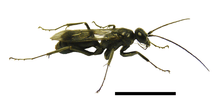Deuteragenia ossarium
| Deuteragenia ossarium | |
|---|---|
 | |
| Scientific classification | |
| Kingdom: | Animalia |
| Phylum: | Arthropoda |
| Class: | Insecta |
| Order: | Hymenoptera |
| Suborder: | Apocrita |
| Family: | Pompilidae |
| Genus: | Deuteragenia |
| Species: | D. ossarium |
| Binomial name | |
| Deuteragenia ossarium Ohl, 2014 | |
Deuteragenia ossarium, "the Bone-house Wasp" is a South-East China species of pompilid wasp named after graveyard bone-houses or ossuaries, from its characteristic use of a vestibular cell filled with dead ants which is built by the female wasp to close the nest after she lays her eggs.[1][2]
This technique is theorized to make the species' nests less vulnerable to predatory enemies than nests of other sympatric trap-nesting wasps, possibly by utilizing chemical cues in odors from the dead ants to camouflage the nest from predators, or repel them.[1][2]
The ant most frequently found in the vestibular cell was Pachycondyla astuta, an aggressive species with a potent sting.[2] D. ossarium parasitism rates were significantly lower than other cavity-nesting wasp species.[1]
References cited
- ↑ 1.0 1.1 1.2 Staab M, Ohl M, Zhu C-D, Klein A-M (2014) A Unique Nest-Protection Strategy in a New Species of Spider Wasp. PLoS ONE 9(7): e101592. http://www.plosone.org/article/info%3Adoi%2F10.1371%2Fjournal.pone.0101592
- ↑ 2.0 2.1 2.2 Megan Gannon, News Editor, LiveScience: Newfound Wasp Literally Has Skeletons in Its Closet, http://news.yahoo.com/newfound-wasp-literally-skeletons-closet-190118261.html, July 2, 2014.